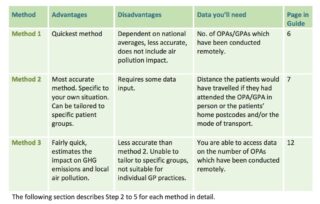The COVID-19 pandemic put an immense burden on the NHS. It required the health care system to adapt in order to be able to continue with its services. Offering many health services remotely, from GP to ophthalmic services, is an example.
The NHS is responsible for about 4% of the UK’s total carbon emissions and has committed to reaching net zero greenhouse gas emissions by 2045.
Enabling patients to access remote consultations alongside in-person appointments not only limits the spread of infection, but helps meet the rising demand for health care as well as reducing the NHS’ carbon footprint.
Greenhouse gas (GHG) emissions related to patient travel currently contribute to 5% of the NHS footprint. Overall, the NHS is responsible for about 4% of the UK’s total carbon emissions and has committed to reaching net zero greenhouse gas emissions by 2045.
Remote consultations will never be the only form of appointments. In-person appointments and remote consultations are both essential in delivering health care. Work is being done to understand which are the most appropriate services to offer remotely and how the switch from in-person appointments to remote consultations has affected patients, staff and quality of care.
If the NHS is to fulfil its requirements of the NHS Long Term Plan and meet its net zero targets, not only do we need to understand how remote consultations affect clinical and patient outcomes, but also how they impact the environment.
Remote consultations: do they reduce greenhouse gas emissions?
At the Centre for Sustainable Healthcare, my team and I work with health care professionals to reduce the environmental impact of their activities.
The remote consultations reduced hospital visits and with the help of the calculator, we were able to estimate the CO2e emissions saved by avoiding unnecessary patient journeys to hospital.
To make it easy for health professionals, quality improvement leads, sustainability and practice managers at hospitals and GP practices to measure the environmental impact of switching to remote consultations, we have developed a supportive guide.
Funded through Q by the Health Foundation and NHS England and NHS Improvement, the guide describes step-by-step three different methods for calculating the greenhouse gas emission savings of avoided patient travel, pictured below. A new carbon calculator in the form of an Excel spreadsheet has been developed for method 2.
The guide can be used for a specific clinical pathway, a clinical department, or a whole organisation.
Which method you decide to use depends on how much time you have, what you would like to use the results for and what data you are able to access or collect. Whether you plan to collect detailed travel data from individual patients or would just like to make a quick estimate, you will be able to choose the method that is right for your analysis.
The table below provides a summary of each method.

How is the guide being used?
The guide went to GPs, hospitals and a quality improvement project for feedback. A scholar in Sustainable Ophthalmology at Barts NHS Trust who used the guide said:
‘It was a unique and valuable opportunity using the Carbon footprint calculator for our sustainability project ‘Telephone Cataract Consultations’ that took place at Eye Treatment Centre WXUH in 2021. The remote consultations reduced hospital visits and with the help of the calculator, we were able to estimate the CO2e emissions saved by avoiding unnecessary patient journeys to hospital.
‘The calculator is user friendly, requires only essential data to be added, and is already preprogramed to calculate miles travelled/avoided, CO2e emissions produced/saved for a single and a return journey. The calculator comes with a guide that not only explains how to use the calculator or how the data are generated, but also describes different methods how to calculate CO2e savings depending on the goal of the study.’
The guide also includes an outline on how to estimate the carbon footprint of the change in resource use at the GP practice or hospital due to the switch to remote consultations.
Find out more and use the guide and calculator on the Centre for Sustainable Healthcare website.
More information
Read more about the guide on the Centre for Sustainable Healthcare blog.
Comments
Bernard Clayton 9 Oct 2022
Nowadays, the only activity that may make you happy is travel. I enjoy travelling, but occasionally I have problems locating tickets and making hotel reservations. I don't always have the money to purchase tickets on favourable terms, but I was told to visit site and find what I wanted there. I appreciate my family for suggesting this service to me. And if you hunt for alternatives or consult your friends, you can also do the same. I hope you all have a fantastic journey and holiday!